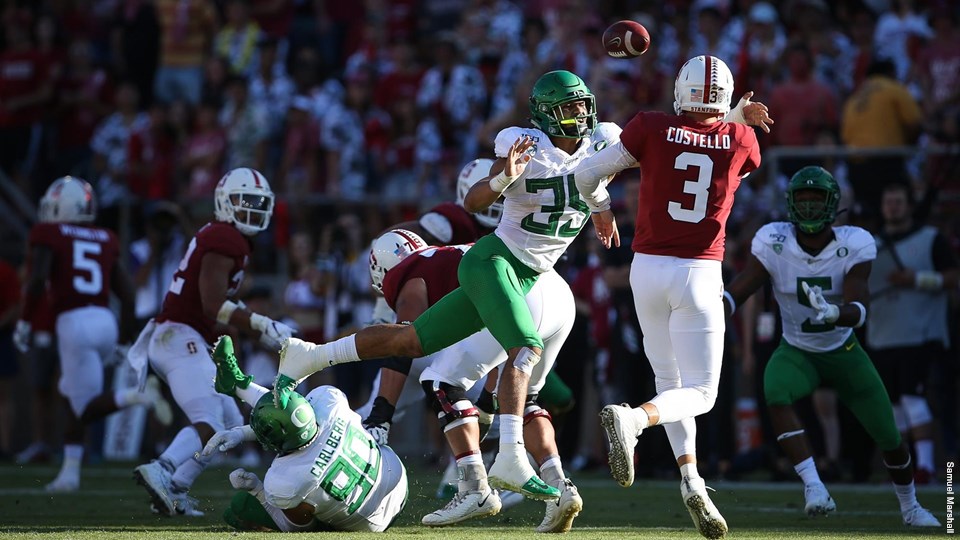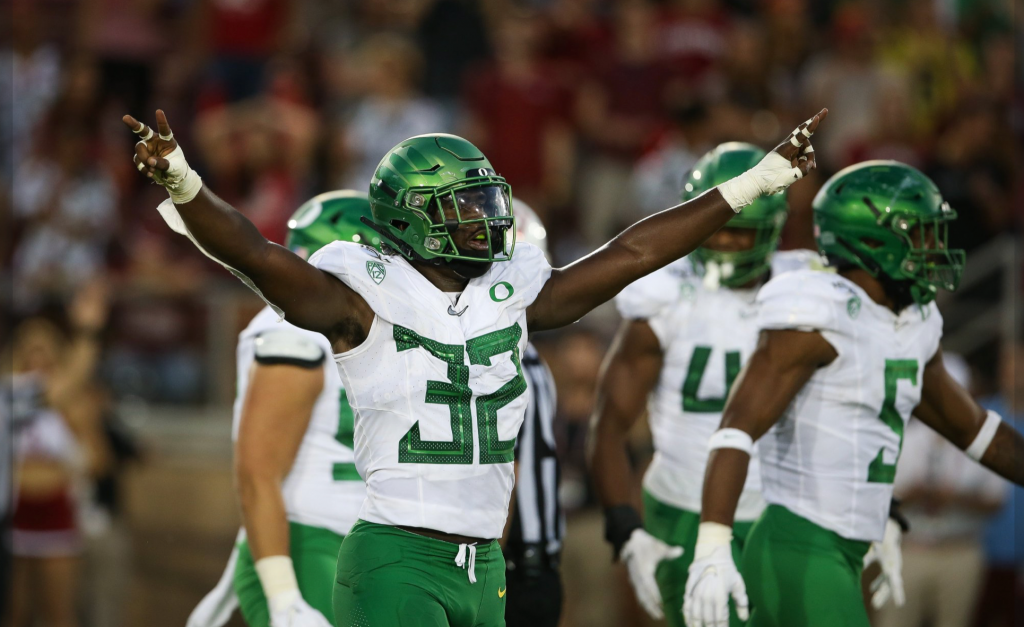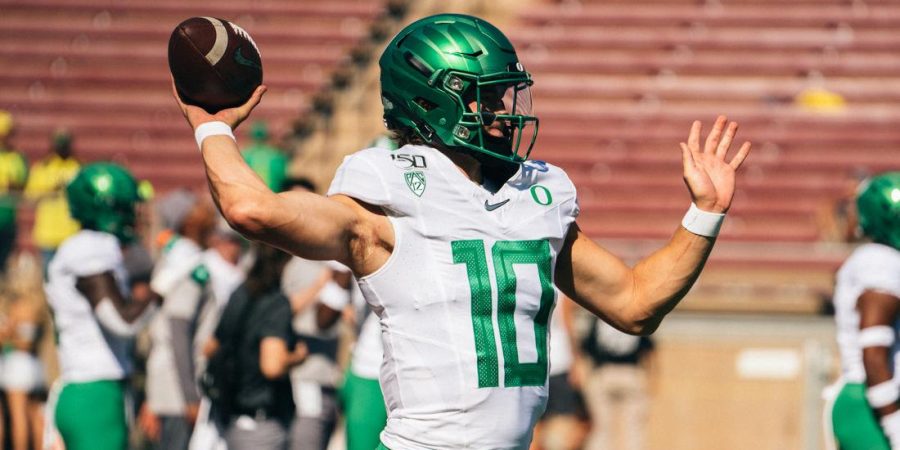A win is a win is a win, and while the 16th-ranked Ducks picked up their first win in a Pac-12 opener since 2014, they looked anything but complete in their 21-6 victory over the Stanford Cardinal Saturday night in Palo Alto.
Buoyed once again by a dominating defensive effort and a virtually spotless performance from quarterback Justin Herbert, the Ducks looked like the stronger, more prepared team throughout the game. However, as good as Herbert and the defense looked, the ground game – which was cited as a significant concern in the build up to Saturday’s game – failed to once again look like anything resembling a reliable unit as Oregon heads into the bye week.
Below, WFOD offers up its major takeaways from an incomplete win that moves the Ducks to 3-1 overall, and 1-0 in conference play.
1. Sound the alarm: Oregon’s running game is officially a problem
It was an issue that was somewhat underlying last season, but has quickly become something far more alarming this season. In short, it’s safe to say that the Ducks are a subpar operation when it comes to running the football. In the season opener vs. Auburn, Oregon’s struggles with the run game could be reasonably explained by Auburn’s defensive line, which is perhaps the most talented defensive front in the country. Against Nevada and Montana, the lack of production on the ground could be blamed on an Oregon team that was more or less scoring at will thanks to an opportunistic defense and big plays through the air on offense. But after an anemic showing against Stanford on Saturday, there are no more excuses for an offense and a coaching staff that has seemingly bent over backwards to fruitlessly prove that physicality and owning the line of scrimmage is a central tenant under head coach Mario Cristobal.
Against the Cardinal, the Ducks rushed for just 61 yards on 30 carries (two yards/attempt), their lowest yards per carry average since last year’s Redbox Bowl victory over Michigan State (1.37 yards/attempt). In fact, Oregon’s two yards per carry average is the third lowest yards per carry average in a single game since Cristobal took over as head coach. It’s also the sixth time the Ducks have been held under three yards per carry in a single game over that 18-game span.
At times, it’s been difficult to put a finger on what exactly the true issue is. Yet, as time goes on, it appears – at least from this perspective – that Oregon’s rushing woes are a concerning combination of lackluster personnel and a faulty scheme. After seeing limited action the previous two weeks, CJ Verdell appeared to be Cristobal’s preferred feature back vs. Stanford. In that role, the sophomore slogged his way to 82 yards on 24 carries (3.4 yards/attempt), showcasing limited ability in terms of patience, vision, and consistency breaking tackles; three things that have capped Verdell’s potential production on the ground over the course of his career. Unfortunately for Oregon, backups like Travis Dye and Cyrus Habibi-Likio haven’t faired much better when they’ve received their opportunities to shine. There’s also a fair amount of criticism to be shouldered by the coaching staff, which has remained steadfastly committed to running the ball out of the Pistol formation despite its apparent inefficiencies.
Fortunately for the Ducks, the Cardinal were no threat to put points on the board and make Saturday’s game interesting, but with a rugged Pac-12 schedule ahead of them, Oregon must address its rushing woes. If not, it’s bound cost them a winnable game down the road.

2. The Oregon defense continues its streak of keeping opponents out of the end zone
When is the last time the Ducks have prevented an opponent from reaching the end zone in three straight games? The year was 1935, and the opponents were Oregon State, Portland State, and Washington. Fast forward 84 years, and the Oregon defense has done it again, this time against Nevada, Montana, and now Stanford. If that weren’t impressive enough, Saturday’s win over the Cardinal marked the first time since 1968 that the Ducks have held three consecutive opponents to single digits in scoring. The Ducks are also only one of four teams in FBS who have not allowed a touchdown in the first half of a game this season.
The Ducks were led in tackles by Thomas Graham (nine) and Jevon Holland (eight), who continue to prove they are worthy of all-conference consideration at season’s end. The Oregon defense was also paced by five sacks from five different players, led by Gus Cumberlander’s 1.5 sacks. As a team, the Ducks have now tallied 15 sacks through four games, and are primed to move up the national rankings in that category following Saturday’s thoroughly dominant performance. Despite the lopsided showing from the offense, Oregon’s defense continues to look very capable of carrying this team as they attempt to iron out their issues on the other side of the ball.
Incredible job by Oregon’s three man rush to get the sack on Costello on 3rd and 10. https://t.co/HV3RK4MFJR pic.twitter.com/uvrRLV1pPp
— Kevin Wade (@KwadeSays) September 22, 2019
3. The Herbert to Breeland connection has never looked better
Until the Ducks welcome back their full complement of receivers, it’s tough to definitively say that Justin Herbert has a favorite target in what has been an effective Oregon passing attack through four weeks of play. However, there’s certainly been no one thus far who has demonstrated a better connection with Herbert than senior tight end Jacob Breeland, who had yet another tremendous outing Saturday.
Entering the day as the team leader in touchdown receptions, Breeland would pad that lead with a pair of touchdown receptions coming on five catches for 78 yards, which led all Oregon pass catchers vs. the Cardinal. Herbert also continued his ruthlessly efficient aerial onslaught this season, completing 19-of-24 passes for 259 yards and three touchdowns. His 13 touchdown passes over the last three games are the most in school history over a three-game stretch.
That pump fake from Herbert was so filthy it needs to take a shower. pic.twitter.com/YdjTmyo8Jh
— Kevin Wade (@KwadeSays) September 22, 2019
4. The performance of Oregon’s special teams is kind of what you make of it
Is Oregon’s special teams good? Is it bad? On Saturday, it was kind of both.
The good came courtesy of senior punter Blake Maimone, who continued his terrific start to the 2019 season by averaging just over 45 yards per punt (45.7) and pinning Stanford inside their own 20 on five of his six punt attempts. His consistency in this area of the game has been monumental in providing the Oregon defense with advantageous starting field position throughout the season, and it continued Saturday as the Cardinal’s average starting position on offense was their own 19-yard line.
The bad, however, was something that has plagued the Ducks since the graduation of Aidan Schneider at the end of the 2017 season – inconsistent field goal kicking. Relying on a true freshman kicker is always a harrowing thought if you’re a football coach, but those nerves increase exponentially when you’ve gone four games without successfully converting a field goal attempt. The true freshman in this case is Camden Lewis, who edged out Adam Stack (who has since transferred from the program) during fall camp, but has demonstrated little in the way of proving himself as a reliable weapon. His 20-yard missed field goal attempt loomed large in the season opening loss to Auburn, and while his missed 27-yard attempt vs. Stanford had no such impact (and could be easily attributed to a poor snap from Karsten Battles), it’s not the kind of thing that engenders much confidence should Oregon need three points at a critical juncture in the games to come.

5. Ducks make it to the fourth quarter without committing a penalty
One could argue that perhaps the biggest on-field change that has been made since Mario Cristobal took over as head coach is the fact that Oregon has been nothing short of amazing when it comes to limiting the number of penalties they incur. In Willie Taggart’s only season as head coach, the Ducks were the nation’s most penalized team, both in terms of penalties per game (9.4) and penalty yards per game (88.3). That all changed in Cristobal’s first year in the saddle, as Oregon’s nearly cleaved those totals in half last season, finishing second in the conference in penalties per game (5.0) and fourth in penalty yards per game (47.9).
Amazingly, those stats have only improved this season. Entering Saturday, the Ducks ranked second in the conference in penalties (5.0) and penalty yards per game (37.3), and should see those numbers only increase after incurring just two penalties for 30 yards vs. Stanford on Saturday. In fact, Oregon’s first penalty of the game didn’t come until late in the fourth quarter with the game already on ice.
Items of note:
- The Oregon defense has allowed a touchdown in just two of the last 20 quarters dating back to last season. The defense has also an interception in 11 of its last 13 games dating back to last season.
- Ducks cornerback Thomas Graham matched a career-high with nine tackles while breaking up two passes
- Safety Jevon Holland came away with his seventh career interception and second of the season with his fourth quarter pick
- Tight end Jacob Breeland has hauled in a touchdown in three straight games for the first time in his career
- Punter Blake Maimone pinned a career-high five punts inside the 20, finishing with six punts for an average of 45.7 yards with a long of 57

